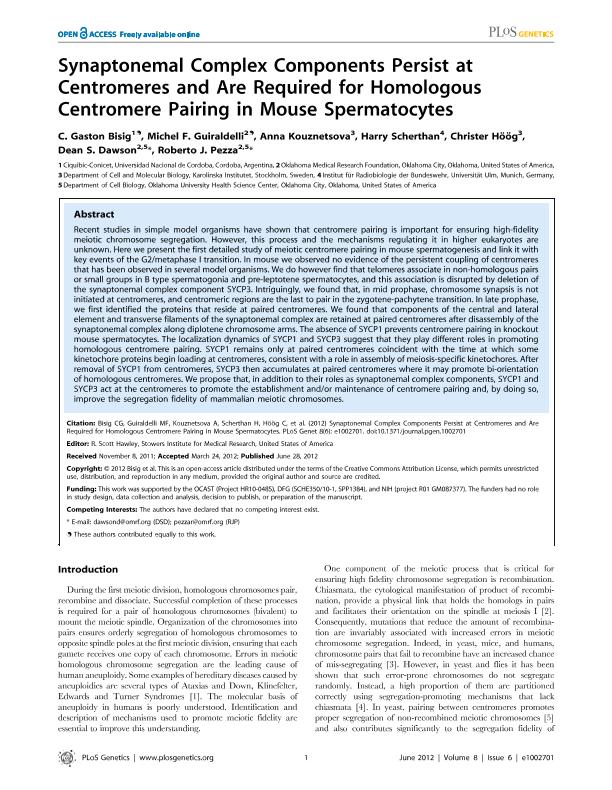Mostrar el registro sencillo del ítem
dc.contributor.author
Bisig, Carlos Gaston

dc.contributor.author
Guiraldelli, Michel F.
dc.contributor.author
Kouznetsova, Anna
dc.contributor.author
Scherthan, Harry
dc.contributor.author
Höög, Christer
dc.contributor.author
Dawson, Dean S.
dc.contributor.author
Pezza, Roberto J.
dc.date.available
2024-03-07T09:55:39Z
dc.date.issued
2012-06-28
dc.identifier.citation
Bisig, Carlos Gaston; Guiraldelli, Michel F.; Kouznetsova, Anna; Scherthan, Harry; Höög, Christer; et al.; Synaptonemal complex components persist at centromeres and are required for homologous centromere pairing in mouse spermatocytes; Public Library of Science; Plos Genetics; 8; 6; 28-6-2012; 1-13
dc.identifier.issn
1553-7390
dc.identifier.uri
http://hdl.handle.net/11336/229572
dc.description.abstract
Recent studies in simple model organisms have shown that centromere pairing is important for ensuring high-fidelity meiotic chromosome segregation. However, this process and the mechanisms regulating it in higher eukaryotes are unknown. Here we present the first detailed study of meiotic centromere pairing in mouse spermatogenesis and link it with key events of the G2/metaphase I transition. In mouse we observed no evidence of the persistent coupling of centromeres that has been observed in several model organisms. We do however find that telomeres associate in non-homologous pairs or small groups in B type spermatogonia and pre-leptotene spermatocytes, and this association is disrupted by deletion of the synaptonemal complex component SYCP3. Intriguingly, we found that, in mid prophase, chromosome synapsis is not initiated at centromeres, and centromeric regions are the last to pair in the zygotene-pachytene transition. In late prophase, we first identified the proteins that reside at paired centromeres. We found that components of the central and lateral element and transverse filaments of the synaptonemal complex are retained at paired centromeres after disassembly of the synaptonemal complex along diplotene chromosome arms. The absence of SYCP1 prevents centromere pairing in knockout mouse spermatocytes. The localization dynamics of SYCP1 and SYCP3 suggest that they play different roles in promoting homologous centromere pairing. SYCP1 remains only at paired centromeres coincident with the time at which some kinetochore proteins begin loading at centromeres, consistent with a role in assembly of meiosis-specific kinetochores. After removal of SYCP1 from centromeres, SYCP3 then accumulates at paired centromeres where it may promote bi-orientation of homologous centromeres. We propose that, in addition to their roles as synaptonemal complex components, SYCP1 and SYCP3 act at the centromeres to promote the establishment and/or maintenance of centromere pairing and, by doing so, improve the segregation fidelity of mammalian meiotic chromosomes.
dc.format
application/pdf
dc.language.iso
eng
dc.publisher
Public Library of Science

dc.rights
info:eu-repo/semantics/openAccess
dc.rights.uri
https://creativecommons.org/licenses/by-nc-sa/2.5/ar/
dc.subject
Synaptonemal Complex
dc.subject
Homologous Centromere Pairing
dc.subject
Spermatocytes
dc.subject
Tubulin
dc.subject.classification
Biología Celular, Microbiología

dc.subject.classification
Ciencias Biológicas

dc.subject.classification
CIENCIAS NATURALES Y EXACTAS

dc.title
Synaptonemal complex components persist at centromeres and are required for homologous centromere pairing in mouse spermatocytes
dc.type
info:eu-repo/semantics/article
dc.type
info:ar-repo/semantics/artículo
dc.type
info:eu-repo/semantics/publishedVersion
dc.date.updated
2024-03-05T13:25:56Z
dc.identifier.eissn
1553-7404
dc.journal.volume
8
dc.journal.number
6
dc.journal.pagination
1-13
dc.journal.pais
Estados Unidos

dc.journal.ciudad
San Francisco
dc.description.fil
Fil: Bisig, Carlos Gaston. Consejo Nacional de Investigaciones Científicas y Técnicas. Centro Científico Tecnológico Conicet - Córdoba. Centro de Investigaciones en Química Biológica de Córdoba. Universidad Nacional de Córdoba. Facultad de Ciencias Químicas. Centro de Investigaciones en Química Biológica de Córdoba; Argentina
dc.description.fil
Fil: Guiraldelli, Michel F.. Oklahoma Medical Research Foundation; Estados Unidos
dc.description.fil
Fil: Kouznetsova, Anna. Karolinska Institute; Suecia
dc.description.fil
Fil: Scherthan, Harry. Universitat Ulm; Alemania
dc.description.fil
Fil: Höög, Christer. Karolinska Institutet. Department of Cell and Molecular Biology; Suecia
dc.description.fil
Fil: Dawson, Dean S.. Oklahoma Medical Research Foundation; Estados Unidos. Oklahoma State University; Estados Unidos
dc.description.fil
Fil: Pezza, Roberto J.. Oklahoma Medical Research Foundation; Estados Unidos. Oklahoma State University; Estados Unidos
dc.journal.title
Plos Genetics

dc.relation.alternativeid
info:eu-repo/semantics/altIdentifier/url/https://journals.plos.org/plosgenetics/article?id=10.1371/journal.pgen.1002701
dc.relation.alternativeid
info:eu-repo/semantics/altIdentifier/doi/http://dx.doi.org/10.1371/journal.pgen.1002701
Archivos asociados
